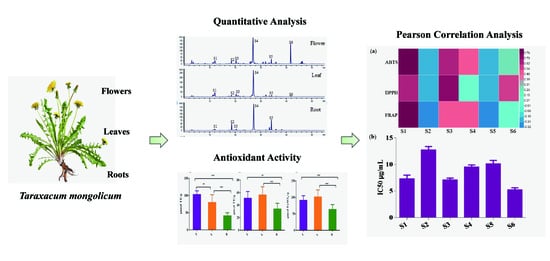Comparison of Bioactive Phenolic Compounds and Antioxidant Activities of Different Parts of Taraxacum mongolicum
Abstract
1. Introduction
2. Results and Discussion
2.1. Comparison of Six Bioactive Phenolic Compounds in Different Parts of Taraxacum mongolicum
2.1.1. Optimization of Extraction Conditions
2.1.2. Method Validation of HPLC Analysis
2.1.3. Determination of Six Bioactive Phenolic Compounds in Different Parts of Taraxacum mongolicum
2.1.4. Multivariate Statistical Analysis
2.2. Comparison of Six Bioactive Phenolic Compounds in Different Parts of Taraxacum mongolicum
2.3. The Potential Antioxidant Constitutes of Taraxacum mongolicum
3. Materials and Methods
3.1. Plant Materials
3.2. Chemicals and Reagents
3.3. Preparation of Sample and Standard Solutions
3.4. HPLC Analysis
3.5. Method Validation of HPLC Analysis
3.6. Determination of Total Phenolic Contents
3.7. Determination of Total Flavonoid Contents
3.8. Antioxidant Assays
3.8.1. DPPH Scavenging Activity Assay
3.8.2. ABTS Radical Scavenging Activity Assay
3.8.3. Ferric Reducing Antioxidant Power (FRAP) Assay
3.8.4. Antioxidant Activities of Six Bioactive Phenolic Compounds
3.9. Data Analysis
4. Conclusions
Author Contributions
Funding
Conflicts of Interest
References
- Sarı, A.; Keçeci, Z. Phenolic compounds from Taraxacum bessarabicum (Hornem.) Hand.-Mazz. subsp. bessarabicum. Planta Med. 2012, 78, 1225. [Google Scholar]
- Mahboubi, M. Hepatoprotection by dandelion (Taraxacum officinale) and mechanisms. Asian Pac. J. Trop. Biomed. 2020, 10, 1–10. [Google Scholar] [CrossRef]
- Shi, S.; Huang, K.; Zhang, Y.; Liu, S. Preparative isolation and purification of two flavonoid glycosides from Taraxacum mongolicum by high-speed counter-current chromatography. Sep. Purif. Technol. 2008, 60, 81–85. [Google Scholar] [CrossRef]
- Sweeney, B.; Vora, M.; Ulbricht, C. Evidence-based systematic review of dandelion (Taraxacum officinale) by natural standard research collaboration. J. Herb. Pharm. 2005, 5, 79–93. [Google Scholar] [CrossRef]
- Hagymási, K.; Blázovics, A.; Fehér, J. The in vitro effect of dandelions antioxidants on microsomal lipid peroxidation. Phytother. Res. 2000, 14, 43–44. [Google Scholar] [CrossRef]
- Mingarro, D.M.; Plaza, A.; Galan, A.; Vicente, J.A.; Martinez, M.P.; Acero, N. The effect of five Taraxacum species on in vitro and in vivo antioxidant and antiproliferative activity. Food Funct. 2015, 6, 2787–2793. [Google Scholar] [CrossRef]
- Sharifi-Rad, M.; Roberts, T.H.; Matthews, K.R.; Bezerra, C.F.; Morais-Braga, M.F.B.; Coutinho, H.D.M.; Sharopov, F.; Salehi, B.; Yousaf, Z.; Sharifi-Rad, M.; et al. Ethnobotany of the genus Taraxacum-phytochemicals and antimicrobial activity. Phytother. Res. 2018, 32, 2131–2145. [Google Scholar] [CrossRef]
- Dias, M.I.; Barros, L.; Alves, R.C.; Oliveira, M.B.P.P.; Santos-Buelga, C.; Ferreira, I.C.F.R. Nutritional composition, antioxidant activity and phenolic compounds of wild Taraxacum sect. Ruderalia. Food Res. Int. 2014, 56, 266–271. [Google Scholar] [CrossRef]
- Schütz, K.; Carle, R.; Schieber, A. Taraxacum—A review on its phytochemical and pharmacological profile. J. Ethnopharmacol. 2006, 107, 313–323. [Google Scholar] [CrossRef]
- Liu, J.; Li, X.M.; Shi, D.D.; Wen, Z.G.; Yang, P.L. Effect of quality control on the proliferation of the extract from Taraxacum mongolicum Hand.-Mazz. in Lactobacillus plantarum. Biomed. Chromatogr. 2019, 33, e4687. [Google Scholar] [CrossRef]
- Jedrejek, D.; Lis, B.; Rolnik, A.; Stochmal, A.; Olas, B. Comparative phytochemical, cytotoxicity, antioxidant and haemostatic studies of Taraxacum officinale root preparations. Food Chem. Toxicol. 2019, 126, 233–247. [Google Scholar] [CrossRef]
- Gomez, M.K.; Singh, J.; Acharya, P.; Jayaprakasha, G.K.; Patil, B.S. Identification and quantification of phytochemicals, antioxidant activity, and bile acid-binding capacity of garnet stem dandelion (Taraxacum officinale). J. Food Sci. 2018, 83, 1569–1578. [Google Scholar] [CrossRef]
- Borek, C. Antioxidant health effects of aged garlic extract. J. Nutr. 2001, 131, 1010S–1015S. [Google Scholar] [CrossRef] [PubMed]
- Molinu, M.G.; Piluzza, G.; Campesi, G.; Sulas, L.; Re, G.A. Antioxidant sources from leaves of Russian dandelion. Chem. Biodivers. 2019, 16, e1900250. [Google Scholar] [CrossRef]
- Miłek, M.; Marcinčáková, D.; Legáth, J. Polyphenols content, antioxidant Activity, and cytotoxicity assessment of Taraxacum officinale extracts prepared through the micelle-mediated extraction method. Molecules 2019, 24, 1025. [Google Scholar] [CrossRef]
- Liu, A.P.; Gou, L.X.; Xue, Z.J.; Zheng, Y.G.; Guo, L. Quality evaluation of Taraxaci Herba based on fingerprint analysis and quantitative analysis of multi-components. Zhongguo Zhong Yao Za Zhi 2018, 43, 3715–3721. [Google Scholar]
- Da, J.; Wu, W.Y.; Hou, J.J.; Long, H.L.; Yao, S.; Yang, Z.; Cai, L.Y.; Yang, M.; Jiang, B.H.; Liu, X.; et al. Comparison of two officinal Chinese Pharmacopoeia species of Ganoderma based on chemical research with multiple technologies and chemometrics analysis. J. Chromatogr. A 2012, 1222, 59–70. [Google Scholar] [CrossRef] [PubMed]
- Li, P.; Zeng, S.L.; Duan, L.; Ma, X.D.; Dou, L.L.; Wang, L.J.; Li, L.; Bi, Z.M.; Liu, E.H. Comparison of Aurantii Fructus Immaturus and Aurantii Fructus based on multiple chromatographic analysis and chemometrics methods. J. Chromatogr. A 2016, 1469, 96–107. [Google Scholar] [CrossRef] [PubMed]
- Wang, M.; Wang, Q.; Yang, Q.; Yan, X.; Feng, S.; Wang, Z. Comparison of anthraquinones, iridoid glycosides and triterpenoids in Morinda officinalis and Morinda citrifolia using UPLC/Q-TOF-MS and multivariate statistical analysis. Molecules 2020, 25, 160. [Google Scholar] [CrossRef]
- Duan, L.; Guo, L.; Dou, L.L.; Yu, K.Y.; Liu, E.H.; Li, P. Comparison of chemical profiling and antioxidant activities of fruits, leaves, branches, and flowers of Citrus Grandis ‘Tomentosa’. J. Agric. Food Chem. 2014, 64, 11122–11129. [Google Scholar] [CrossRef]
- Polumackanycz, M.; Sledzinski, T.; Goyke, E.; Wesolowski, M.; Viapiana, A. A comparative study on the phenolic composition and biological activities of Morus alba L. commercial samples. Molecules 2019, 24, 3082. [Google Scholar] [CrossRef] [PubMed]
- Shi, S.; Zhao, Y.; Zhou, H.; Zhang, Y.; Jiang, X.; Huang, K. Identification of antioxidants from Taraxacum mongolicum by high-performance liquid chromatography-diode array detection-radical-scavenging detection-electrospray ionization mass spectrometry and nuclear magnetic resonance experiments. J. Chromatogr. A 2008, 1209, 145–152. [Google Scholar] [CrossRef] [PubMed]
- Singleton, Y.I.; Rossi, J.A. Colorimetry of total phenolics with phophomolybdic-phosphotunstic acid reagents. Am. J. Enol. Vitic. 1965, 16, 144–158. [Google Scholar]
- Jia, Z.; Tang, M.; Wu, J. The determination of flavonoid contents in mulberry and their scavenging effects on superoxide radicals. Food Chem. 1999, 64, 555–559. [Google Scholar]
- Tuberoso, C.I.G.; Rosa, A.; Bifulco, E.; Melis, M.P.; Atzeri, A.; Pirisi, F.M.; Dessi, M.A. Chemical composition and antioxidant activities of Myrtus communis L. berries extracts. Food Chem. 2010, 12, 1242–1251. [Google Scholar] [CrossRef]
- Yongram, C.; Sungthong, B.; Puthongking, P.; Weerapreeyakul, N. Chemical composition, antioxidant and cytotoxicity activities of leaves, bark, twigs and oleo-resin of Dipterocarpus Alatus. Molecules 2019, 24, 3083. [Google Scholar] [CrossRef] [PubMed]
- Fan, S.; Yang, G.; Zhang, J.; Li, J.; Bai, B. Optimization of ultrasound-assisted extraction using response surface methodology for simultaneous quantitation of six flavonoids in Flos Sophorae Immaturus and antioxidant activity. Molecules 2020, 25, 1767. [Google Scholar] [CrossRef]
- Szewczyk, K.; Bogucka-Kocka, A.; Vorobets, N.; Grzywa-Celińska, A.; Granica, S. Phenolic composition of the leaves of Pyrola rotundifolia L. and their antioxidant and cytotoxic activity. Molecules 2020, 25, 1749. [Google Scholar] [CrossRef]
- Benzie, I.F.F.; Strain, J.J. The ferric reducing ability of plasma (FRAP) as a measure of “antioxidant power”: The FRAP assay. Anal. Biochem. 1996, 239, 70–76. [Google Scholar] [CrossRef]
- Chen, L.; Xin, X.; Feng, H.; Li, S.; Cao, Q.; Wang, X.; Vriesekoop, F. Isolation and identification of anthocyanin component in the fruits of Acanthopanax Sessiliflorus (Rupr. & Maxim.) seem. by means of high speed counter current chromatography and evaluation of its antioxidant activity. Molecules 2020, 25, 1781. [Google Scholar]
Sample Availability: Samples of the compounds including caftaric acid, chlorogenic acid, caffeic acid, cichoric acid, 3,5-di-O-caffeoylquinic acid and luteolin are available from the authors. |

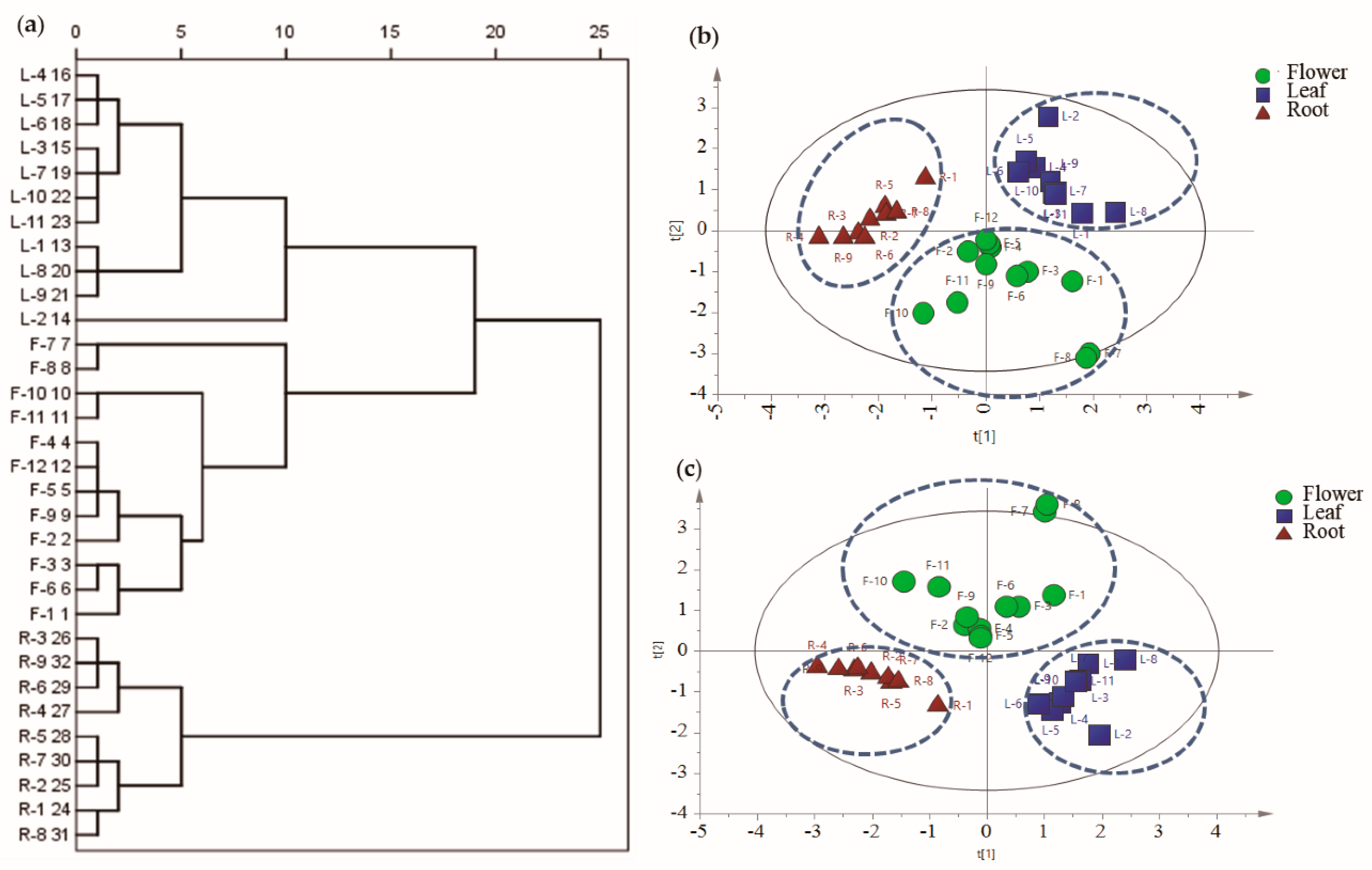
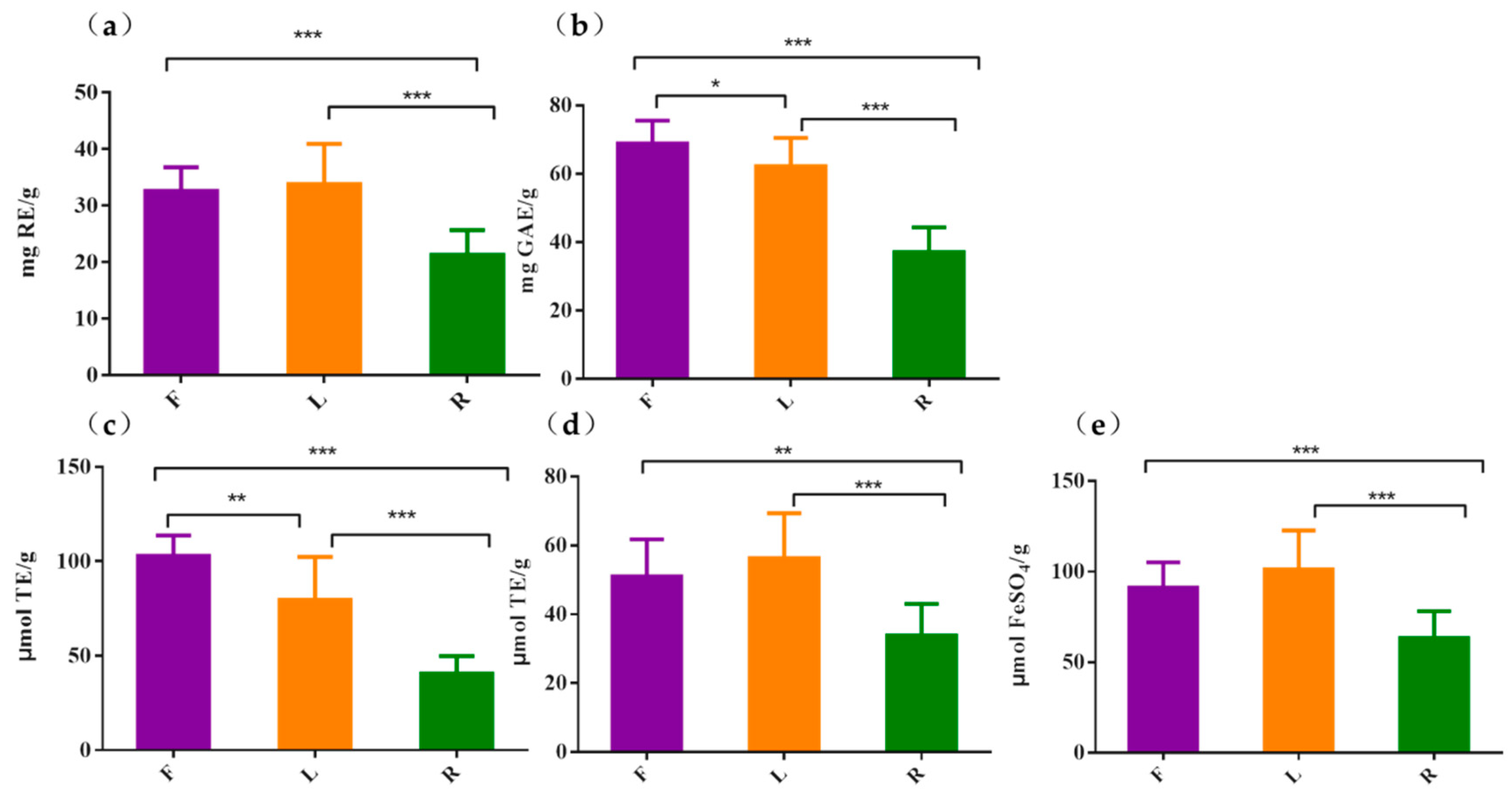
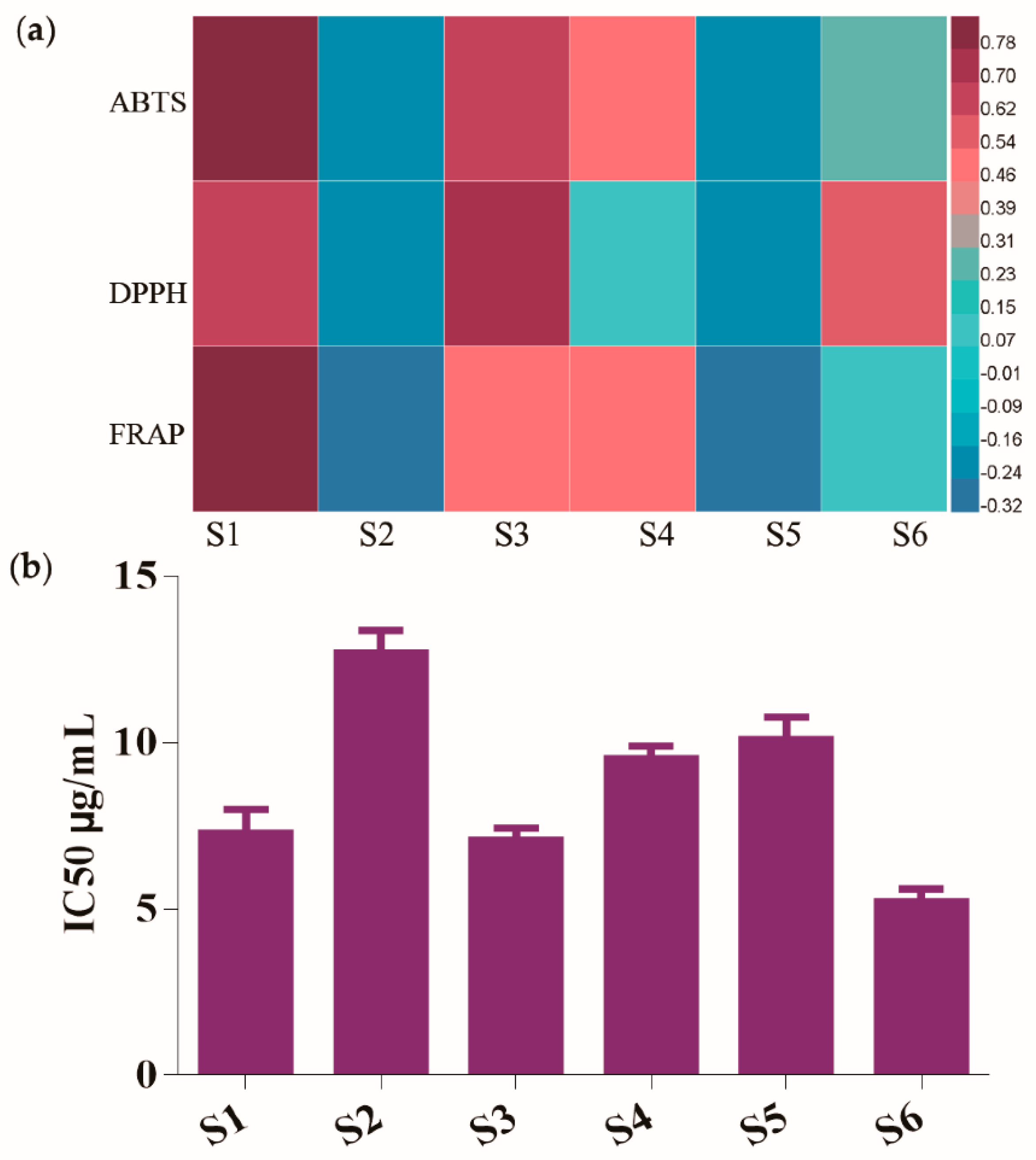
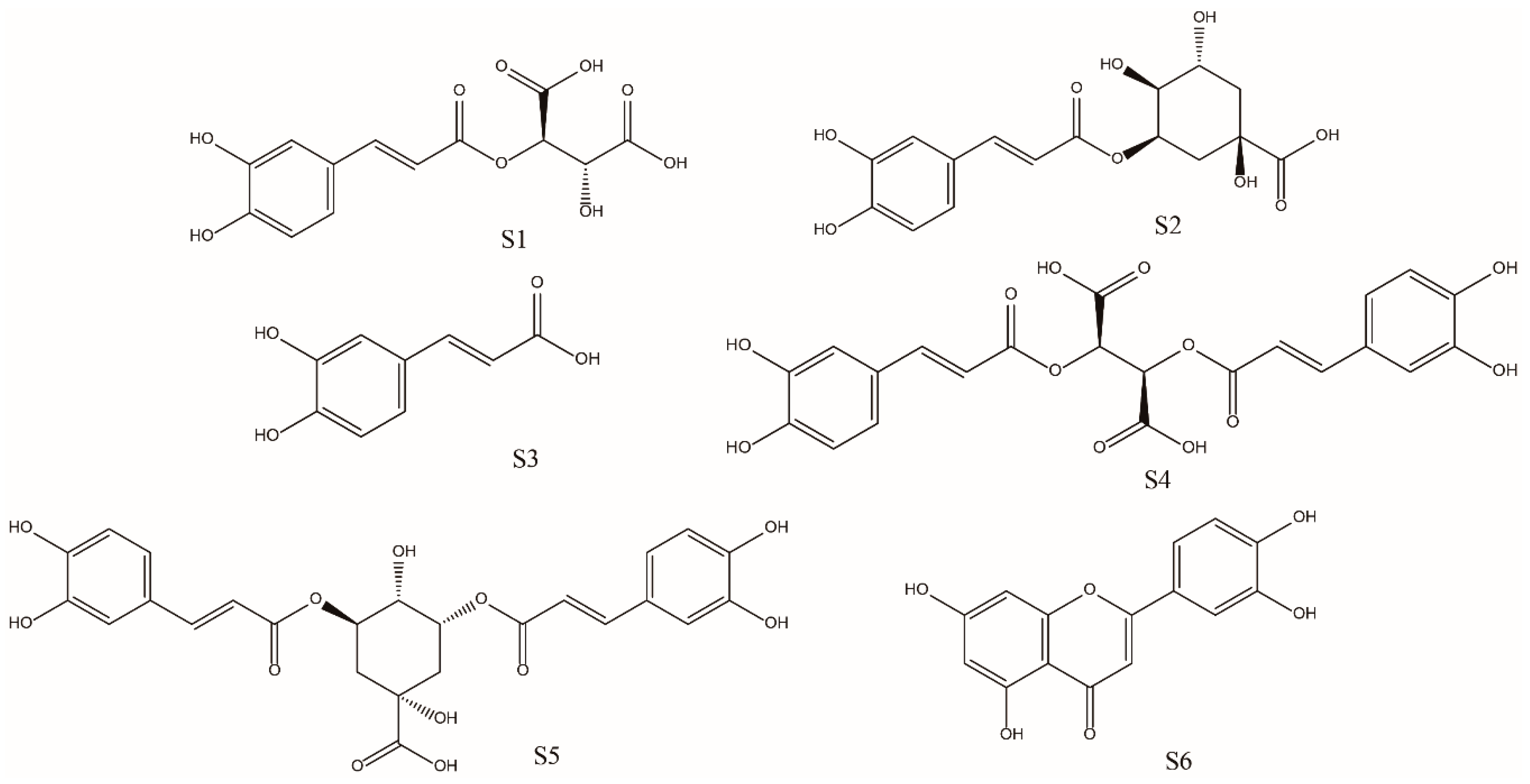
| Compound | Regression Equation | r2 | Linear Range (mg/L) | LOQ (mg/L) | LOD (mg/L) | Precision (RSD, %) | Stability (48 h) RSD (%) | Repeatability (n = 6) RSD (%) | Recovery (n = 6) | ||
|---|---|---|---|---|---|---|---|---|---|---|---|
| Intra-Day (n = 6) | Inter-Day (n = 9) | Recovery (%) | RSD (%) | ||||||||
| Caftaric Acid | y = 33.203x + 25.550 | 0.9999 | 2.66–170 | 0.053 | 0.027 | 0.65 | 1.43 | 1.35 | 1.64 | 94.03 | 2.05 |
| Chlorogenic Acid | y = 33.339x + 0.306 | 0.9999 | 0.47–60 | 0.188 | 0.043 | 0.90 | 1.28 | 1.28 | 1.76 | 95.89 | 2.30 |
| Caffeic Acid | y = 53.817x − 4.734 | 0.9999 | 0.53–64 | 0.042 | 0.016 | 0.97 | 1.68 | 1.76 | 0.45 | 93.76 | 1.88 |
| Cichoric Acid | y = 43.518x − 33.429 | 0.9999 | 3.39–435 | 0.047 | 0.024 | 0.51 | 0.59 | 0.59 | 0.94 | 108.73 | 2.97 |
| 3,5-di-O-Caffeoylquinic Acid | y = 38.534x − 1.189 | 0.9998 | 0.69–88 | 0.055 | 0.028 | 1.22 | 1.04 | 1.04 | 1.11 | 99.63 | 2.79 |
| Luteolin | y = 49.205x + 21.672 | 0.9999 | 0.22–225 | 0.088 | 0.022 | 0.66 | 1.56 | 1.56 | 1.57 | 104.65 | 2.89 |
| NO. | Caftaric Acid | Chlorogenic Acid | Caffeic Acid | Cichoric Acid | 3,5-di-O-Caffeoylquinic Acid | Luteolin |
|---|---|---|---|---|---|---|
| F1 | 0.775 | 0.15 | 0.619 | 1.494 | 0.345 | 0.626 |
| F2 | 0.926 | 0.466 | 0.423 | 4.826 | 0.736 | 0.716 |
| F3 | 1.126 | 0.376 | 0.524 | 2.799 | 0.496 | 0.683 |
| F4 | 0.698 | 0.339 | 0.229 | 3.803 | 0.456 | 1.308 |
| F5 | 0.675 | 0.321 | 0.257 | 3.301 | 0.444 | 0.944 |
| F6 | 1.073 | 0.365 | 0.535 | 2.363 | 0.582 | 0.476 |
| F7 | 1.101 | 0.311 | 0.592 | 2.049 | 0.449 | 2.762 |
| F8 | 1.399 | 0.414 | 0.738 | 2.934 | 0.611 | 2.506 |
| F9 | 0.557 | 0.295 | 0.218 | 2.746 | 0.499 | 1.373 |
| F10 | 1.056 | 0.567 | 0.533 | 2.507 | 1.235 | 0.412 |
| F11 | 0.997 | 0.506 | 0.541 | 2.524 | 0.966 | 0.549 |
| F12 | 0.745 | 0.368 | 0.261 | 3.94 | 0.449 | 1.006 |
| L1 | 1.051 | 0.085 | 0.37 | 1.9 | 0.087 | 0.09 |
| L2 | 1.798 | 0.397 | 0.312 | 9.337 | 0.203 | 0.028 |
| L3 | 1.854 | 0.392 | 0.356 | 4.301 | 0.264 | 0.027 |
| L4 | 1.242 | 0.271 | 0.248 | 5.191 | 0.191 | 0.097 |
| L5 | 1.158 | 0.279 | 0.208 | 5.295 | 0.168 | 0.067 |
| L6 | 1.021 | 0.264 | 0.16 | 4.393 | 0.156 | 0.166 |
| L7 | 1.746 | 0.336 | 0.366 | 4.462 | 0.302 | 0.036 |
| L8 | 1.537 | 0.095 | 0.37 | 2.359 | 0.063 | 0.396 |
| L9 | 0.877 | 0.081 | 0.182 | 2.812 | 0.085 | 0.076 |
| L10 | 1.58 | 0.287 | 0.342 | 4.183 | 0.289 | 0.045 |
| L11 | 1.543 | 0.228 | 0.298 | 3.52 | 0.302 | 0.046 |
| R1 | 0.398 | 0.358 | 0.086 | 4.928 | 0.49 | - 1 |
| R2 | 0.418 | 0.404 | 0.143 | 4.75 | 1.137 | - |
| R3 | 0.207 | 0.549 | 0.073 | 2.624 | 0.734 | 0.014 |
| R4 | 0.292 | 0.734 | 0.092 | 3.566 | 0.881 | - |
| R5 | 0.443 | 0.445 | 0.149 | 5.012 | 0.893 | - |
| R6 | 0.156 | 0.509 | 0.06 | 1.896 | 0.684 | - |
| R7 | 0.397 | 0.42 | 0.144 | 4.383 | 0.9 | - |
| R8 | 0.296 | 0.4 | 0.11 | 3.649 | 0.707 | - |
| R9 | 0.18 | 0.597 | 0.054 | 2.367 | 0.754 | - |
© 2020 by the authors. Licensee MDPI, Basel, Switzerland. This article is an open access article distributed under the terms and conditions of the Creative Commons Attribution (CC BY) license (http://creativecommons.org/licenses/by/4.0/).
Share and Cite
Duan, L.; Zhang, C.; Zhao, Y.; Chang, Y.; Guo, L. Comparison of Bioactive Phenolic Compounds and Antioxidant Activities of Different Parts of Taraxacum mongolicum. Molecules 2020, 25, 3260. https://doi.org/10.3390/molecules25143260
Duan L, Zhang C, Zhao Y, Chang Y, Guo L. Comparison of Bioactive Phenolic Compounds and Antioxidant Activities of Different Parts of Taraxacum mongolicum. Molecules. 2020; 25(14):3260. https://doi.org/10.3390/molecules25143260
Chicago/Turabian StyleDuan, Li, Chenmeng Zhang, Yang Zhao, Yanzhong Chang, and Long Guo. 2020. "Comparison of Bioactive Phenolic Compounds and Antioxidant Activities of Different Parts of Taraxacum mongolicum" Molecules 25, no. 14: 3260. https://doi.org/10.3390/molecules25143260
APA StyleDuan, L., Zhang, C., Zhao, Y., Chang, Y., & Guo, L. (2020). Comparison of Bioactive Phenolic Compounds and Antioxidant Activities of Different Parts of Taraxacum mongolicum. Molecules, 25(14), 3260. https://doi.org/10.3390/molecules25143260






